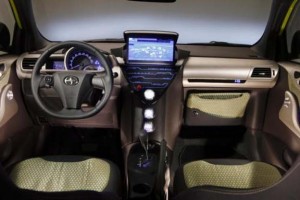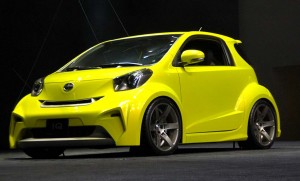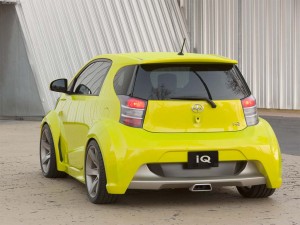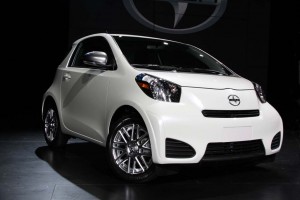There’s one thing you can be guaranteed will happen when driving the new Scion iQ: expect to get plenty of stares, folks routinely stopping to ask you about the little microcar.
Measuring barely five feet tall and 10 feet nose-to-tail, the 2012 Scion iQ isn’t the smallest car on U.S. roads but it comes awfully close, somehow squeezing four seats into a footprint only 14 inches longer than the 2-seat Smart fortwo.
But this is no pedal car. At $15,995, Scion will be commanding something of a premium considering what other makers are charging for their current subcompact offerings. Perhaps that can be expected in the electronics world: you pay more for a smaller smartphone or MP3 player. But getting motorists to pay more for less car is a challenge that few have so far pulled off, notably British marque Mini.
Once you get past its miniscule size, the 2012 Scion iQ doesn’t look like a tin econobox. A tweaked and update version of the European Toyota iQ, it has a reasonably substantial look and feel to it that comes in sharp contrast to some past small cars that made you wonder what you were risking by slipping inside.
Clearly, Toyota made a major effort to deliver a microcar that lived up to the brand’s reputation for tight fits and on-the-nail quality. If we found a single issue after poring over our test car it was a slight misalignment in the two inside door handles – and even that appeared to be more a visual miscue than an actual defect.
Like many modern small cars, the new iQ opts for a relatively tall cabin, at least compared to its overall length. This approach creates a much more roomy interior package than you might otherwise expect, even though the cabin is still a bit cramped, with a back seat that only barely slips into the usable category.
But the interior is surprisingly well-appointed, with nice details such as the sporty, flat-bottomed steering wheel. There’s a nice mix of chrome and pewter accents completed by the piano-black finish around the center display. Gauges and controls are well-placed and easy to reach. The center speedo display is mated to a small digital readout that is legible but not nearly as appealing as the motorcycle-style display serving similar purpose on the new Chevrolet Sonic.
If there’s a drawback it’s the seats, which are thin and cheap feeling, almost like they were lifted out of a ‘70s-era econobox. But they’re more comfortable than they look – at least on relatively short drives.
Another disappointment is the lack of much useful storage, with no functional glovebox, just a little tray under the passenger seat.
Under the tiny hood one finds a port-injected, 1329 cc inline-four engine making 94 horsepower and 89 pound-feet of torque. Not exactly a rocket, but that’s reasonable for a car weighing in at just 2,150 pounds. The specs tell you it’ll take nearly 12 seconds to get to 60, with a top speed – if you have a long enough road – to hit 100. In practice, perhaps it’s the miniscule size of the 2012 Scion iQ but it feels a bit faster than the numbers would imply.

Scion has delivered a reasonably well-executed interior in what others might have considered a basic econobox.
It has enough oomph – okay, just barely – to let you feel comfortable in a passing maneuver on a two-lane blacktop if there’s no oncoming traffic.
The little four is mated to a Continuously Variable Transmission and under hard acceleration it seems pinned to the 4,000 rev mark, inducing that dreaded rubber-banding that is the nature of the CVT. We’d certainly prefer the manual gearbox offered in the European Toyota iQ.
Safety is clearly an issue that a lot of folks wonder and worry about when it comes to small cars. The recent news that the Fiat 500 has won the IIHS Top Safety Pick award (Click Here for the full story) should help potential buyers recognize that small doesn’t have to mean vulnerable. It also helps that Scion is packing 11 airbags into the tiny confines of the 2012 iQ – including the world’s first airbag mounted behind the seats, designed to reduce injuries during a rear-end collision.
More clearly in the plus column, the Scion doesn’t just nudge into the 40 mpg club, as a number of new small cars have done but punch right past it at 50 mpg Highway and an impressive 39 mpg around town – the latter figure better than Smart’s Highway rating.
On the whole, Scion has done a reasonable job with the new iQ considering the severe constraints of a vehicle not much bigger than a golf cart. It’s a hands-down improvement over the Smart fortwo, for one thing. But is that enough to win over many American motorists?
Perhaps for those who can only park it where they used to keep a bicycle. But other than in a few American cities does the size of the 2012 Scion iQ really offer it much of an advantage. So, while there may be a few trend-setters who just have to have the newest, if not greatest, it’s hard to see where there’ll be much of a market.
Toyota’s youth-oriented Scion division took the wraps off the 2012 iQ, an innovative new entry in the growing segment of urban microcars.
Powered by a 1.3-liter, 4-cylinder engine, the iQ stands a mere 59 inches tall, 66 inches wide and 10 feet long. But inside there is more than ample legroom for driver and front-seat passenger. The backseat is more appropriate for one passenger, but the 50/50 fold-down back seat provides decent storage space. The iQ represents an all-new model for Scion.
The most notable feature of the iQ is its 11 standard air bags. Drivers can turn it around in a nimble steering radius of 12.9 feet, which provides maneuverability and ease of parking in narrow city streets.
The car goes on sale in early December, first on the West Coast, said Jack Hollis, Scion vice president. Dealers in the South and Southwest will begin to receive the car in January and February, with the sales launch for the East Coast and Midwest slated for March. The base price, including delivery charge is $15,995.




